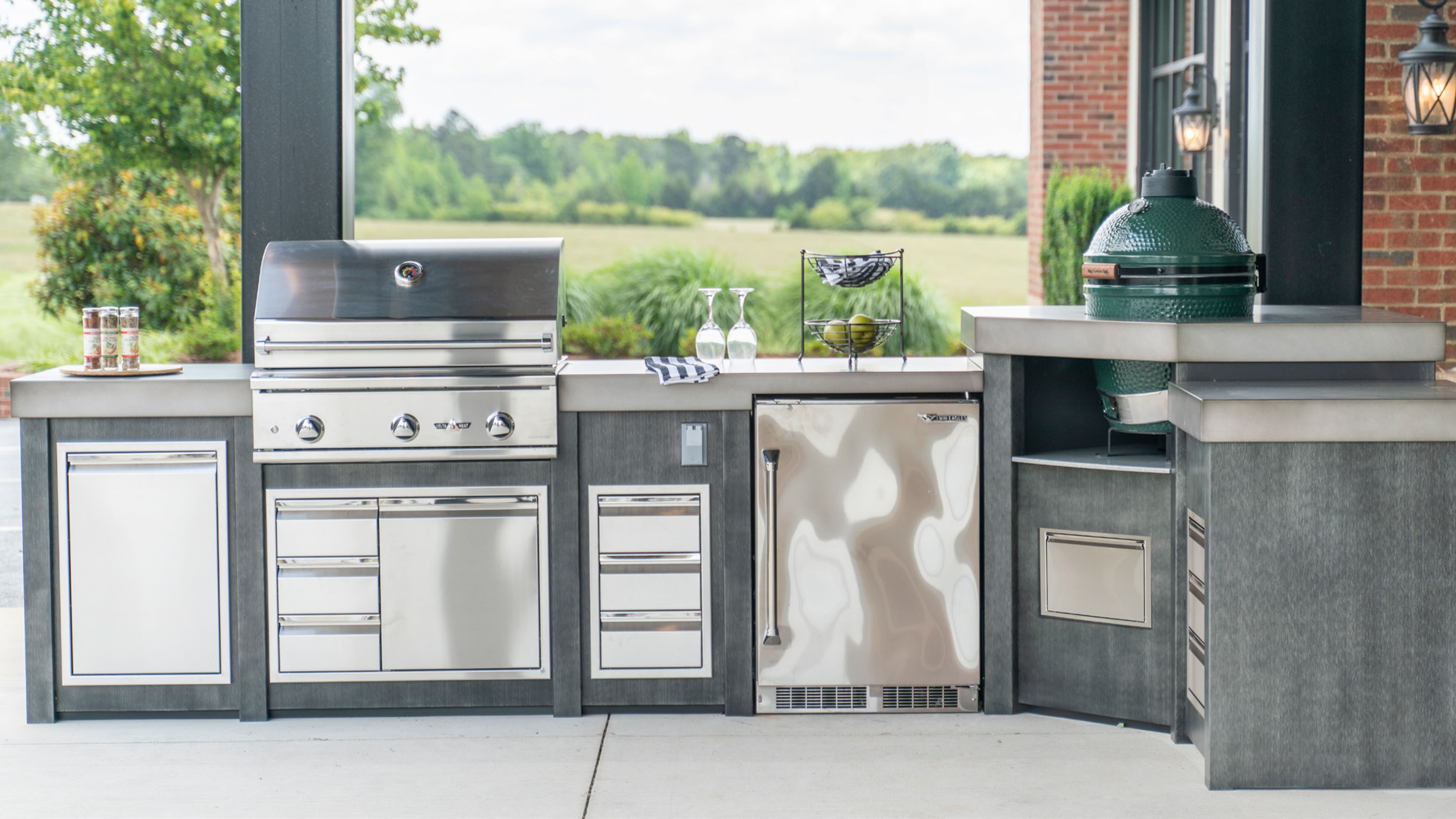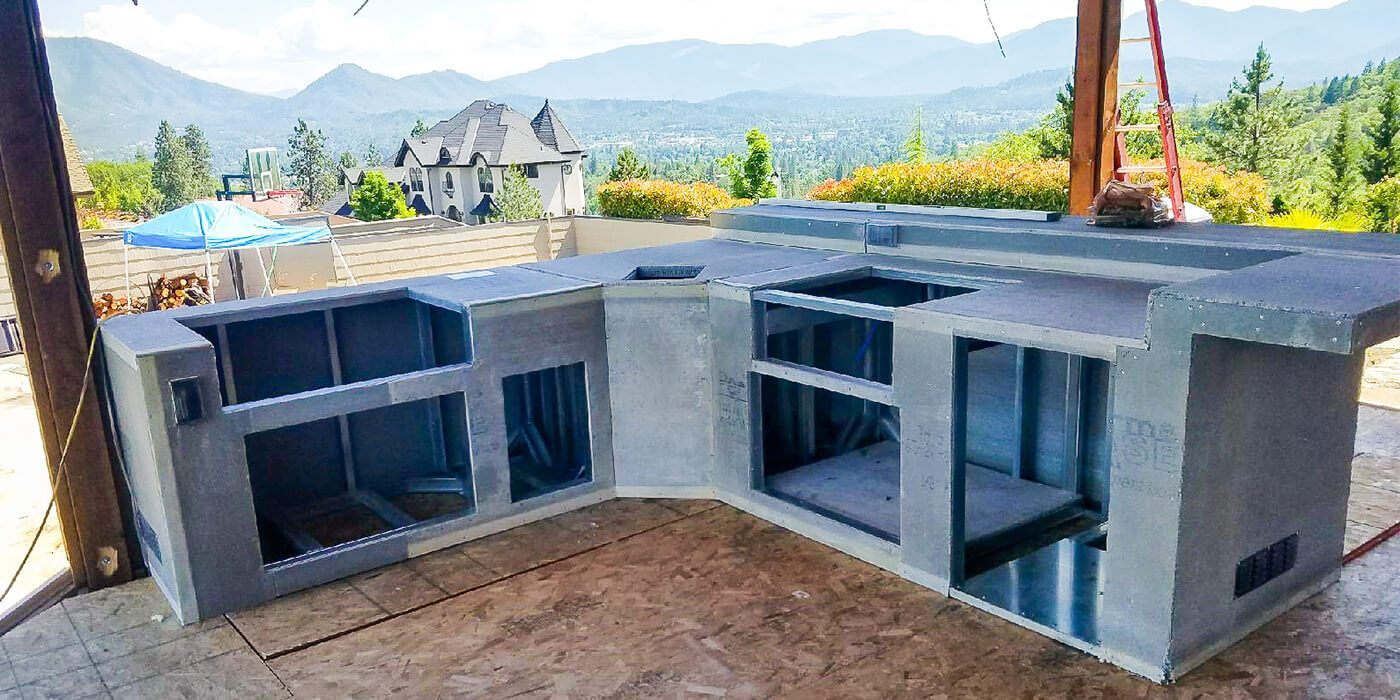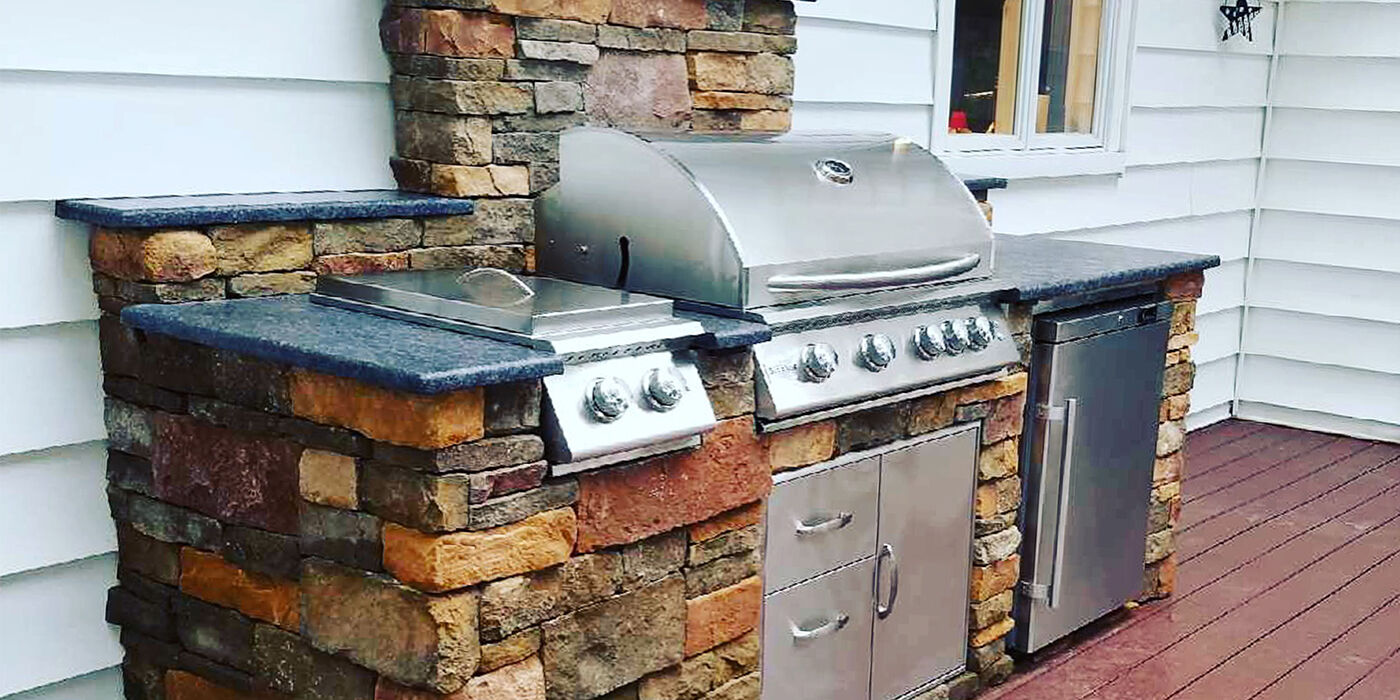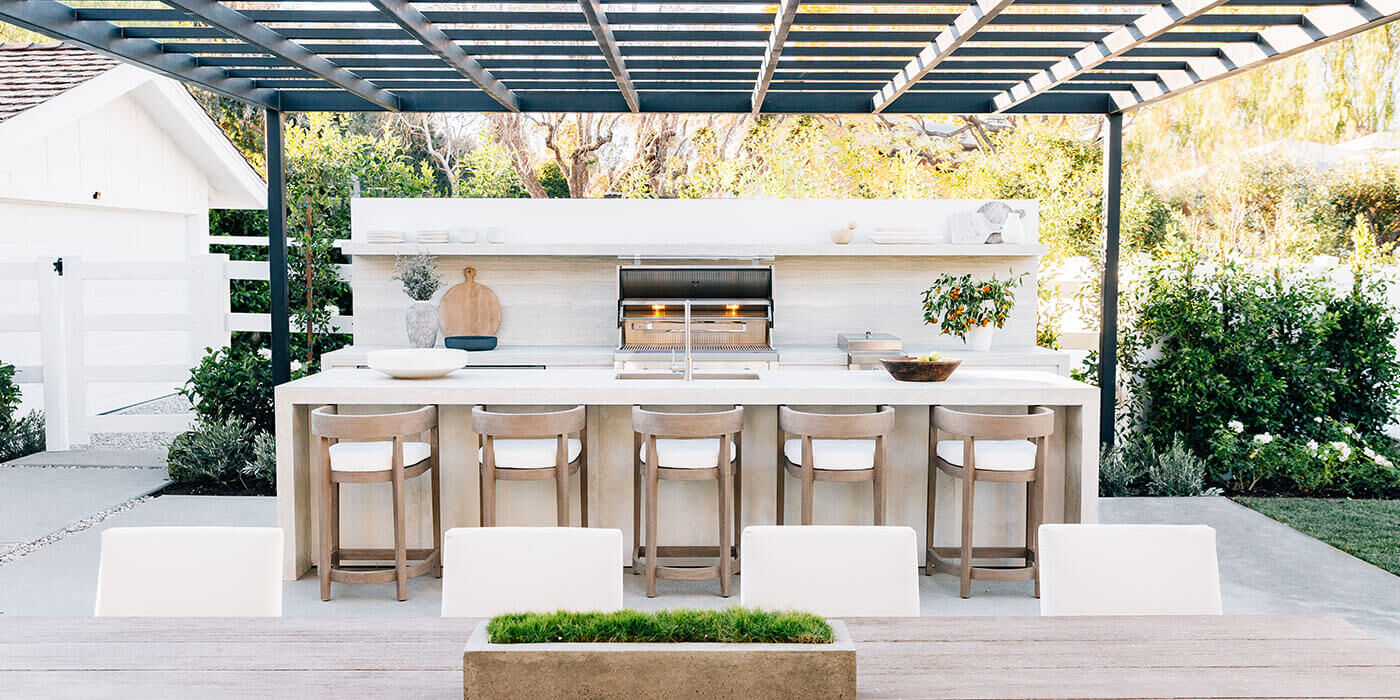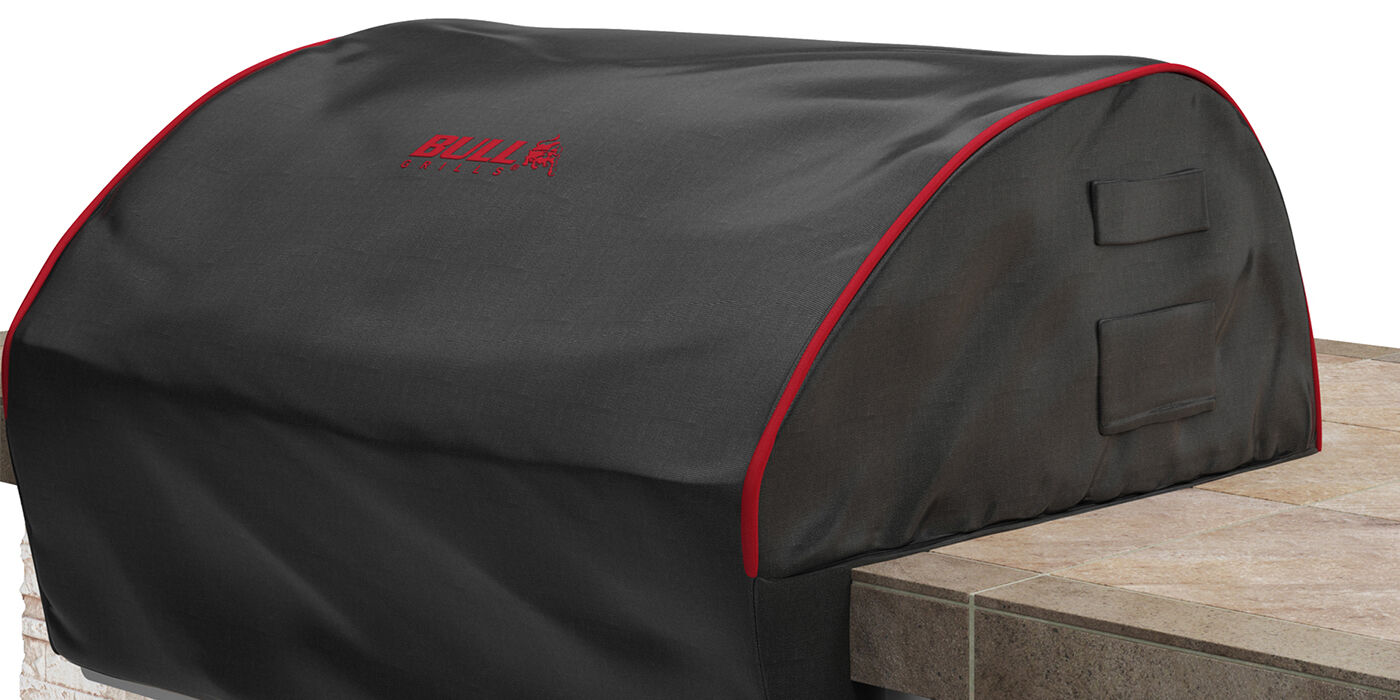By: Garrett Jamieson, NFI Certified Master Hearth Professional
Last Updated: July 16, 2025
Imagine having the ability to prepare all your meals from the comfort of your own backyard, without ever needing to run inside for ingredients, utensils, or a random spice.
Sound too good to be true? It’s possible with an outdoor kitchen!
Outdoor kitchens are becoming more popular among homeowners, and it’s easy to see why. They turn your home into a hospitality hub, offering an al fresco dining experience usually reserved for high-end restaurants.
With an outdoor kitchen, your home also gains extra square footage, without an expensive build-out or time-consuming renovation. In today’s competitive real estate market, that’s a huge advantage.
Before you start building your outdoor kitchen, there are a few important things you should consider. To make your project easier, we’ve put together a guide that outlines each decision you’ll need to make.
But remember, our team of experts is always available to answer any additional questions you may have and help you choose the right components for your outdoor kitchen design.
1. Custom-Built vs Stock
A custom outdoor kitchen offers almost limitless options, making it the premiere choice for customers who want to customize the size, shape, cabinetry, and finish of their outdoor kitchen layout.
With a custom-built kitchen, you’ll get to hand-pick all your components and appliances, right down to the type of granite or stone you’d like for the countertop.
There are also “off-the-shelf" or ready-to-finish outdoor kitchen islands available, which come pre-assembled to make the building process much faster. You’ll simply install the modular kitchen island in your outdoor space, then finish it with the material of your choice.
Prefab outdoor kitchen islands are significantly less expensive than custom-built designs and are ideal for customers who don’t have much space in their backyards to build on.
While ready-to-finish models don’t offer as many customization options, there’s a broad range of layouts on the market to fit outdoor spaces of all sizes and styles.
2. Kitchen Appliances
Every outdoor kitchen island needs a BBQ grill — gas grill, charcoal grill, pellet grill, or hybrid grill — but if you have the space, you may also want to include a refrigerator, sink, ice maker, trash receptacles, and storage space.
Other popular add-ons include side burners, a bar, or a full beverage center if you plan on hosting large backyard gatherings. Some homeowners even install a fire pit or fire table in their outdoor living spaces, giving guests an extra spot to relax and dine.
A common mistake that many homeowners make is not including enough storage space in their outdoor kitchen islands.
If you want the option to cook all your meals outside, without making frequent trips to your indoor kitchen, you’ll need to add kitchen cabinets for utensils, glasses, plates, pots, pans, spices, and more. You’ll also need to include cold storage for your meats, vegetables, fruit, and other perishable foods.
Cooking appliances are the most important part of your outdoor kitchen. We recommend choosing high-quality, rust-resistant components made of stainless steel, so you can enjoy your outdoor kitchen for many years to come.
Any appliance you purchase must be outdoor rated to ensure it will withstand the elements and function properly. For example, a non-outdoor-rated refrigerator may not be able to stay cold enough as it sits outside, leading to spoiled food and health risks.
For help choosing the best grill for your outdoor kitchen, read our grill buying guide.
Pro Tip:
It’s important to check the manufacturer’s requirements outlined in the manual that comes with your appliances, as some products may include “outdoor” in the name but aren’t rated for outdoor use.
3. Layout Options
When you’re designing your dream outdoor kitchen, plan out the different “zones” — cooking space/food prep, sitting room, and entertainment/dining area. This ensures that all the main areas of your backyard mesh together.
Keep in mind that safety regulations require at least 8 inches of space between any installed appliances to prevent them from overheating. This will affect the amount of space your outdoor kitchen will require, so you’ll want to plan the number of appliances to include based on the amount of space you can use.
Your outdoor kitchen should also include proper ventilation. You’ll want to incorporate vents placed 4-6 feet apart along the bottom of your kitchen island to accommodate sufficient cross-ventilation. Without vents, gas can build up in your outdoor kitchen, which may result in an uncontrollable fire or an explosion.
You never know when your outdoor kitchen might need maintenance. Make sure you install service doors for easy access to your appliances. Service doors are also handy for built-in grills, because you’ll be able to store your Propane tank out of view underneath the grill head.
4. Installation Location
Before you can install an outdoor kitchen island on your property, you’ll need to check your local city ordinances. These regulations specify how far away the island should be from combustible materials.
When determining your final location, consider the foot traffic in your outdoor living space. Is your backyard usually busy? Are there certain areas of your yard that are typically more occupied than others?
While your outdoor kitchen certainly serves as a focal point, you don’t want the placement to impede regular backyard activities.
Outdoor kitchen islands also cannot be installed underneath a covered patio or pergola without a vent hood for your grill, and never in an enclosed patio.
5. Delivery & Utilities
When you’re planning your outdoor kitchen, begin with the end in mind.
Unless your kitchen island is built completely on-site, it will need to be moved from its delivery location to the final installation location and may even require a forklift to transport it from the freight truck to your backyard.
Your contractor most likely has experience with handling oversized deliveries and may have a forklift on-hand, so be sure to check with them before you schedule the delivery. If you have questions about this process, please give our team a call. Our certified reps have years of experience handling outdoor kitchen deliveries.
You’ll also need to decide how you want to power your outdoor cooking appliances. Will you need electrical outlets installed in your backyard, or do you need to run a Natural Gas line to your kitchen island? What about running water?
For electric and gas appliances, you’ll need to hire a licensed professional to run hard lines from your home to your outdoor kitchen. You can also have a water line routed to your kitchen island or purchase a small water heater tank and install it underneath the sink.
If you’re connecting to your home’s gas supply, consider the BTU ratings of your appliances. The higher total BTUs of your outdoor kitchen appliances, the more gas you’ll need. Discuss these requirements with your installer, so they can plan accordingly.
6. Safety & Care
If you’re building a custom kitchen island, we recommend using non-combustible materials such as Hardie Board and steel studs.
If you have combustible framing, you should also include an insulated grill jacket for your grill. Grill jackets are specific to certain brands, and not every brand offers them, so make sure you’re selecting the correct grill jacket for the grill model you’ve purchased.
Look at the safety features included with your grill before making a final decision. We recommend buying a grill with a built-in safety system that helps prevent gas buildup and uncontrolled combustion.
Seaside environments can be harsh on outdoor appliances due to salt in the air. If you live near the coast, you’ll want to purchase high-end, stainless steel appliances, which resist corrosion and rust for long-lasting durability in the elements.
Whenever you’re not using your grill, protect it with a fitted, weatherproof cover. You may also want to cover your entire kitchen island. If so, custom covers can be found at your local awning or outdoor fabric supply store that can stretch around the entire perimeter of your kitchen island.
When the season ends and you’ve enjoyed your last meal outside, it’s essential to winterize your outdoor kitchen.
Bring your outdoor refrigerator into the garage, cover your grill for the last time, turn off your gas and water supply, and clear your gas lines. Taking these steps will help prevent any potential damage brought on by cold, harsh weather.
Plan Your Outdoor Kitchen Project
We're Here to Help
Have more questions about outdoor kitchen island? We’d love to help! Call our team of NFI certified experts today at 800-919-1904.
More Resources
Read our Outdoor Kitchen Buying Guide to make sure your cooking station has all the features you need!
Learn the differences between Ready-to-Finish and DIY outdoor kitchens to find the best solution for your project.
Need help designing your Ready-to-Finish outdoor kitchen? Read our buying guide for inspiration.
 |
Garrett Jamieson has been a Technical Sales Representative at Woodland Direct for over a decade. As an NFI-Certified Master Hearth Professional, he's well versed in fire products and safety standards. He strives to help clients understand product features and best installation practices, so they can find products that fit their home and lifestyle. Outside of work, Garrett spends most of his time outside, riding bikes, bowling, camping, grilling, chopping wood, and tackling DIY projects with his family. Call him or one of our experts in fire at 800.919.1904. |
